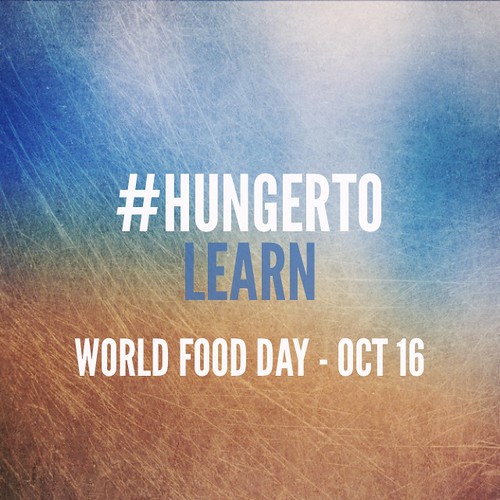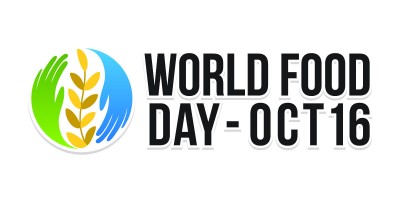October 16th is World Food Day 2013 and the global issues of poverty, food security, and self-reliance continue to be in the news. Family Eats offers up some thoughts on how to participate globally–and in your own home.
- 870 million people do not have enough to eat — more than the populations of USA and the European Union combined.
- 98% of the world’s undernourished people live in developing countries.
- Two-thirds of the world’s hungry live in just 7 countries: Bangladesh, China, the Democratic Republic of the Congo, Ethiopia, India, Indonesia and Pakistan.
- Where is hunger the worst?
- Asia and the Pacific: 578 million
- Sub-Saharan Africa: 239 million
- Latin America and the Caribbean: 53 million
(statistics from The Hunger Project website)
World Food Day
Established by the Food and Agriculture Organization of the United Nations (FAO) in 1979, World Food Day, October 16, was first observed in 1981. Organizations around the world mobilize advocacy campaigns and events on October 16 to strengthen the political will to end hunger. World Food Day offers the opportunity to strengthen national and international solidarity in the struggle against hunger, malnutrition and poverty and draw attention to achievements in food security and agricultural development.
The theme for this year’s World Food Day is “Sustainable Food Systems for Food Security and Nutrition. ” When it comes to food security:
“There are an estimated 842 million hungry people on the planet. This means that one in eight people in the world suffer from chronic hunger, not having enough food for an active and healthy life. Plus the number of people on the planet is increasing rapidly. Production of basic staple foods will need to increase by 60 percent to meet the expected growth in demand.”
The responsibility to act starts right here in our own homes, because the problems we face, both internationally and here in our own country, require change, increased awareness, and the realization that everyone can make a difference. It is time to realize that the issues related to food security–global warming, environment, disease, war and political instability–are issues that ignore borders and affect us all.
Clearly, there is a need to help end hunger throughout the world. And, there are many ways you can help support change.
In his October 14th NY Times opinion article, How to Feed the World, Mark Bittman makes a case for a better way to feed to world than intensifying “industrial agriculture, with more high-tech seeds, chemicals and collateral damage.” In this opinion piece, he clearly draws out the dangers of big agriculture and the trickle down effects it has not only on world stage but in our own kitchens, pointing out that the idea of feeding the world “implies that we have no choice but to intensify industrial agriculture, with more high-tech seeds, chemicals and collateral damage.” But, as Bittman states, this is not the proper mindset. Instead, he points to statistic after statistic that efforts are “geared to letting the half of the planet with money eat well while everyone else scrambles to eat as cheaply as possible.”
It is World Food Day, and while you may think that you’re too far removed from the villages in South Asia,or are unable to help change the way the world farms food, but what goes on in your household has a ripple effect on your community, country, and world.
I am not one of those millions of people who live in poverty and who struggle to nourish their families, yet I do think about how I am going to feed my family on a daily basis. We live on a tight budget, one that stretches our imagination when it comes to feeding a family of six.
We rarely head out to buy fast food. We don’t purchase a lot of packaged foods. We eat together every day. We make our meals from scratch. We make bread for the week, make homemade granola, muffins, and snacks, while pushing the fruits and vegetables as better options than Doritos when after-school hunger strikes. We shop primarily at Whole Foods – the best of our local stores that offer foods and ingredients for the way we eat, aside from the Farmer’s Market.
Our family food ‘standards’ may seem extravagant for some. At times, it is harder, more expensive, and more exhausting to eat this way. Yet even on a tight budget, we choose not to budge on our food choices – even if we’re surrounded by quick eating options, low-cost fast food, and more convenient choices.
That’s not to say that I haven’t been tempted to head on over to Costco and buy in bulk for a reduced price. Or, swing on through McDonald’s for a low-priced, belly filling dinner. Or even switch out our Applegate Farms lunchmeat for a low-cost big brand found at Safeway, but those changes would require us compromising our beliefs in the food system. And, we refuse to let big ag dictate what we eat — however, we can do better.
As Bittman notes when writing about the way to farm and to feed the world, “There are better options.” And, we believe the options we choose for feeding our family are better options–options that can actually make a change.
Yes, that means we spend more for food, but we consume less. No, we’re not starving, we’re just more in line with recommended daily caloric intake.
Yes, I spend more time figuring out how to stretch a dollar, but we’ve found we’re more creative with leftovers, reducing our food waste.
Yes, that means we’re eating less meat, but that means we’re doing our part to help reduce greenhouse gases.
Yes, we’re doing our small part, but we can definitely do more.
Here are a few ways we can all make a change today, on World Food Day, and every day.
Ways to Get Involved
Globally:
- Organize a food packaging event
- Join a local Hunger Coalition
- Participate in World Food Day events – today and every day
- Shop with a Purpose: THP has create many ways that you can shop with a purpose to benefit
- Volunteer your time
- Eat Smart, Eat Healthy
- Reduce your Food Waste
- Reduce Overconsumption
- Buy Locally
- Grow Your Own Food
- Eat Less Food. Eat Less Meat.
- Choose Organic
- Choose GMO Free foods
All of these suggestions do their part to cut down on greenhouse gases, chronic diseases, energy depletion, land depletion, and help feed the world – exactly what we need to do on World Food Day and every day.
This World Food Day, make a pledge to help eradicate hunger in developing nations, and then make a pledge to make a change right in your own home.
Happy Eating!










